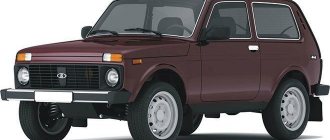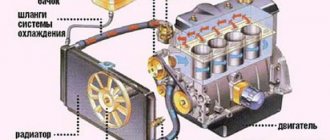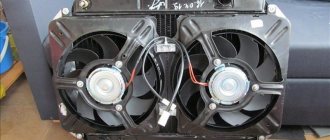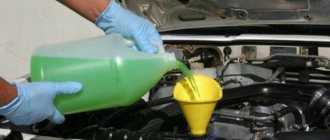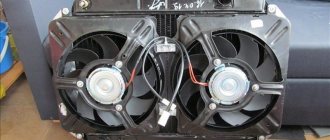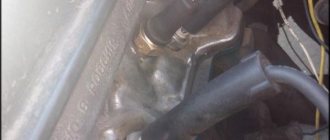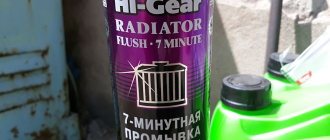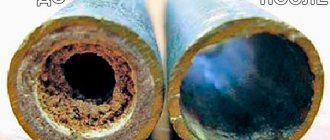In this article we will look at:
- the main causes of clogging of the cooling system,
- how to understand that it’s time to wash,
- how often should you wash?
- what can you wash with?
- How to flush the engine cooling system yourself.
Why do you need to flush the engine cooling system?
The cooling system is an important part of the engine that removes the huge amount of heat generated during engine operation, preventing it from overheating. It is a closed system through which coolant circulates - antifreeze or antifreeze. When the engine is running, the temperature in the cylinders reaches 2000°C, the coolant passing next to the running engine picks up excess heat and removes it.
The cooling system has a rather complex structure. It contains small tubes, pipes, and many channels in which contaminants accumulate. Often they cannot be removed by simply changing the coolant, so flushing is necessary.
Over time, oil and salt deposits, rust, and scale may appear in the cooling system, which settle on the inside of the pipes, in the small channels of the engine and on the radiator itself. All this negatively affects the cooling efficiency of the machine.
As a result, the engine runs at elevated temperatures, problems arise with the oil seals and the entire valve group, and as a result, such an engine becomes completely coked, after which it will have to be spent on a major engine overhaul.
Products for home use
With proper care and preventive maintenance, cleaning the cooling system is not difficult. Before starting the procedure, you need to prepare it:
The engine is cooled if it was running before.- Place a container for old antifreeze under the drain.
- Unscrew the plugs from the bottom of the radiator and cylinders.
- Wait until the liquid is completely drained from the system.
- The drain plugs are screwed back in.
- Fill the expansion tank with cleaner.
Distilled water
If over the past years the car has been kept in order and preventive washes have been carried out, then the use of distilled water is considered sufficient.
It is poured into an empty expansion tank . The amount of distillate must correspond to the volume of the container. After this, start the engine for 10-25 minutes.
For best results, it is recommended to take a test ride. After turning off the car, allow time for cooling and drain the water from the tank.
Lemon acid
This product helps to cope with a small degree of contamination. To prepare the working solution, citric acid is dissolved in water .
The standard proportion is 30-40 g per 1 liter. To enhance the effect, prepare a more concentrated solution, increasing the dose of powder to 80-100 g. The optimal pH value of the lemon reagent is 3.
After the cleaner is poured into the tank, turn on the engine and warm it up for 15-25 minutes. Leave the reagent in the system for 5-12 hours. When draining the solution, visually check the degree of contamination . If necessary, the cleaning procedure is duplicated.
You can learn more about the use of citric acid in the fight against rust here.
The video will show you how to flush the cooling system with citric acid:
Vinegar
For washing, use vinegar with a concentration of 9% . For 5 liters of water you need a glass of acid (250 ml). This cleaner is used by analogy with citric acid.
The acetic reagent is poured into a container from which the antifreeze has previously been drained. Fill the tank with the prepared solution, start the engine for 20-30 minutes. The acetic liquid is drained after 8-12 hours. Flush the system with distillate and fill it with new refrigerant.
You can learn more about the use of vinegar in the fight against rust in this article.
Milk serum
For work, use store-bought or homemade serum . In the latter case, the liquid must be filtered through several layers of gauze so that no curdled inclusions remain in it. The serum should not be diluted with water before use.
The washing solution is prepared from soda ash (8-10%) and caustic (3%) soda.
The powder is diluted with water, its amount in the solution should be 85-90% . After filling the tank with soda reagent, the car is driven 50-100 km. Then the cleaner is drained and the distillate is passed through several times.
The soda solution should not be left in the cooling system for a long time. The maximum time is a day.
The drink contains orthophosphoric acid, which dissolves salt and rust deposits. However, the method is considered not the safest, since acid has a negative effect on rubber pipes, and sugar has a negative effect on metal surfaces.
If the choice is still made on this purifier, then carbon dioxide is first removed from the drink. After filling, the engine is left in working condition for a maximum of 15-20 minutes. After removing the Coca-Cola, the system is cleaned with distilled water. Read more about using Coca-Cola against rust here.
Causes of contamination of the engine cooling system
Antifreeze or antifreeze is used as a coolant in modern cars. These are concentrated solutions that boil away over time and deposits form on the walls of the cooling system.
When the coolant boils away, add distilled water to the system. If you add ordinary tap water instead, it will lead to the deposition of salts on the internal walls of the system. Over time, dust and engine oil also enter the cooling system, all of which also clog the system.
The cooling system becomes dirty when:
- clogging of the cooling system with antifreeze or antifreeze wear products;
- clogging of the external surfaces of the radiator;
- failure of the thermostat, pump, pressure regulating valve, loss of tightness;
- ingress of gas exhaust from the combustion chamber.
If you frequently change the original coolant, flushing the cooling system may not be necessary.
How many liters of coolant are in the Lada Priora cooling system
Before replacing, it is necessary to determine how much antifreeze to fill. According to the passport, the empty system on the Priora contains about 7.84 liters of liquid. However, when replacing, some of the liquid cannot be drained, as a result of which about 6-6.5 liters are often sufficient for replacement.
Taking into account the fact that antifreeze or antifreeze is often sold in the form of a concentrate, the general rule is:
- mixing the concentrate in a ratio of 50:50 (50% antifreeze and 50% water);
- mixing in a ratio of 60:40 (60% antifreeze and 40% water);
These proportions make it possible to obtain the freezing point of the coolant at around -30 or -35 degrees Celsius, which is quite enough for most regions.
It turns out that for replacement you need to purchase 4 liters of concentrate and 4 liters of distilled water. Ready-made antifreeze for Priora will be obtained with a small reserve. This reserve must be drained into an airtight container and stored, since the liquid will be useful for refilling in the future.
How to know when it's time to clean your cooling system
If you flush the cooling system periodically, you don’t have to worry about its condition. What signs should you look for to know it's time to clean your cooling system?
- Frequent sudden increase in engine temperature, leading to overheating.
- Pump malfunctions.
- When the engine is warm, cold air comes out of the heater.
- Constantly increased fan operation.
These signs should raise concern that the engine cooling system is not working as it should.
Recommendations
- Immediately after replacing the coolant, the engine must be warmed up, while simultaneously checking the heating of the lower radiator hose. It should be cold at first, but then quickly warm up. Its heating will indicate that the antifreeze is circulating normally in a large circle.
- Then the engine should continue to warm up until the cooling system fan turns on.
After turning off the fan, turn off the engine and allow the engine to cool. After cooling, unscrew the cap of the expansion tank again and check the fluid level again. If necessary, the normal level in the tank should be set again. - Please note that on models with a cable transmission, the starter will also need to be removed. To do this, you need to remove the negative terminal on the battery. Next, the latch of the wire block is pressed, after which the block is disconnected from the traction relay connector. Then you need to remove the protective cap from the nut securing the wire tip, which is connected to the “plus” wire of the battery.
We also recommend reading the article on how to flush the engine cooling system before replacing the coolant. From this article you will learn about the features of cooling system maintenance, as well as how to flush the engine cooling system correctly.
Using a spanner “13”, unscrew the nut and remove the wire tip from the contact bolt of the traction relay. Now, using a key set to “13”, unscrew the starter mounting bolts (3 pieces), and the starter is removed from the car. If there is a box with traction control, removal of the starter is not required.
How often should you wash?
Flushing the engine cooling system can be internal or external. External treatment consists of flushing the outside of the radiator to remove dirt, dust, and insects. Internal treatment allows you to flush the system from the inside.
Recommendations for the frequency of internal flushing of the cooling system:
- The cooling system should be thoroughly flushed when changing antifreeze or antifreeze. In this case, flushing helps remove the remaining old technical fluid, since it is better not to mix different antifreezes.
- Also, flushing should be carried out for preventive purposes. Carry out washing once a year, it is better to do this in the spring season. Such manipulation will help solve many problems caused by clogged pipes, deterioration of their throughput and heat transfer.
- If symptoms appear that indicate the need for flushing, it should be carried out immediately before more significant damage occurs.
When is flushing necessary?
Internal cleaning is recommended at least once a year. It is best to do this after winter is over. A light indicator with a picture of a radiator helps determine the exact time. In addition, there are other signs by which one can judge the need for cleansing.
These include:
Systematic engine overheating and failures when starting it.- Inertia of the rheostat, inhibited response to its signal.
- High temperature readings from the coolant sensor.
- Interruptions in the operation of the pump, signaling problems in the system.
- Change in the color and smell of the refrigerant in the expansion tank.
What to choose: home remedies or specialized ones
For washing, you can use both specialized and home remedies. Improvised solutions were mainly used earlier, when there were few specialized automotive chemicals on sale. Now that the choice of means for flushing the cooling system is quite large, few people use home remedies. But they are very effective, inexpensive and always at hand. Therefore, they will always have their supporters.
But still, store-bought ready-made liquids are the best solution. Such substances have the necessary composition that will reliably remove all unnecessary deposits without having a negative effect on car parts.
What you need to know before flushing the engine cooling system
The engine cooling system has a complex structure and includes parts made of different materials: plastic, rubber, various metals, including cast iron, steel and aluminum. All these parts have different resistance to chemical reagents, for example, aluminum is poorly resistant to chlorine and caustic soda. Therefore, before you start flushing the engine cooling system, you should carefully study the composition of the product that is supposed to be used to clean the system so that the product does not destroy its components.
Also, during aggressive flushing of the system, thin channels can become clogged with pieces of rust, scale, and pieces of film of evaporated antifreeze, which can lead to complete blockage of the channels and overheating of the engine in the future. Therefore, it is advisable to fill only with the original coolant recommended by the manufacturer, replace it on time and periodically flush the cooling system so that global problems do not arise later.
Can flushing products damage the system?
Improper use of cooling system cleaning products can cause great harm to your vehicle. To avoid this, you cannot use two or more specialized tools at once. You only need to flush the system with one product. Most solutions are sold in the form of concentrates; they must be diluted, since highly concentrated solutions can destroy rubber and plastic parts, especially acidic preparations.
Flushing the engine cooling system yourself
First, you need to prepare the working fluid; for this you can purchase additives and auto chemicals that are designed specifically for flushing the radiator, or limit yourself to available home remedies. It is not worth using ordinary distilled water for this, since it only cleans the sediment, while dense deposits and calcium deposits remain. Regardless of what means you use to flush the engine cooling system, the sequence of actions is almost the same.
Step-by-step instructions for flushing the cooling system yourself
- wait until the engine cools down . Flushing and changing the coolant is done on a cold car, so you need to wait until the engine cools down, which will protect it from thermal deformation as a result of significant temperature fluctuations. Pouring cold wash solution and cold antifreeze into a hot engine can cause the engine cylinder head to crack or the valve cover to move, which will require expensive repairs. Therefore, you should never rush when performing such maintenance.
- Drain the used antifreeze . At the same time, you should pay attention to its transparency: if it is cloudy, it requires repeated cleaning. Draining the coolant is a simple process. You should unscrew the radiator caps and drain the old antifreeze, then unscrew the cap in the expansion tank. Afterwards, you need to drain the antifreeze from the engine, for which you find a drain plug on the crankcase and unscrew it, wait until the liquid drains completely.
- Pour cleaner into the radiator. All pipes and plugs are screwed back in, after which the required volume of flushing fluid is poured into the radiator.
- Leave the car idling for 20-30 minutes. The engine starts and warms up to operating temperature. This will allow the cleaning solution to circulate through the system, flushing out any deposits. The instructions for a specific product contain information on the operating time of the engine to completely clean the system of contaminants.
- Turn off the car engine and wait for it to cool for 2 hours . After completing the flushing, you need to turn off the engine, let it cool for at least 30 minutes, then pour the fluid out of the engine and add new antifreeze. In some cases, it is necessary to bleed the system by pressing on the pipes to expel air bubbles from the system.
- Discard the cleaning solution . The procedure is repeated as when draining used coolant.
- Assess the condition of the liquid: if it has changed significantly, you need to repeat the procedure.
How and with what to flush the cooling system on a VAZ-2110
Many people start flushing the system by draining the old antifreeze. In vain, because first of all it is necessary to keep the radiator and engine clean.
Mechanical cleaning of the radiator.
If the radiator honeycombs are clogged from the outside with dirt, leaves, flies and winter road fill, there can be no talk of any cooling. The same applies to the cylinder block and engine head. Some engines are difficult to see from under a layer of dirt and oil mixture that covers the entire engine. Naturally, the heat transfer of such engines suffers greatly.
That is why, first of all, it is worth thoroughly flushing the engine and radiator outside. It is advisable to use any detergents and water under reasonable pressure for this. It is better not to get too excited with pressure, since strong pressure can damage the radiator honeycombs. There are special means for externally flushing the radiator, but practice shows that they differ from dishwashing detergents only by being overpriced.
Will folk remedies help?
Folk remedies for flushing can be quite effective, but use them at your own peril and risk.
But to flush the system from the inside, folk remedies are not enough. No Coca-Cola or other nasty stuff is good for this.
All this can only make the situation worse. It is also unacceptable to flush the system with well water or tap water - this water is too hard, which implies a huge amount of salts and minerals. They will definitely settle on the walls of the water jacket and radiator honeycombs from the inside and will completely ruin the cooling system, although after draining plain water it may look perfectly clean, causing the illusion of a sterile system.
Chemistry comes to the rescue!
The inside of the system is washed only with special products, which are abundant in stores and are inexpensive compared to a new radiator. All these means are aimed at decomposing and removing organic fats and mineral scale, which is what clogs the system the most. In general terms, all flushes are divided into several types:
- Alkaline washings are inexpensive but ineffective means, although with a low degree of contamination they can bring a positive result.
- Two-component washes . When using them, you must strictly adhere to the instructions; they are poured in a certain sequence; after each cycle, the system is washed with distilled water. The result is very good.
The two-component set consists of an acid and an alkaline wash.
“Soft” flushing is suitable if the antifreeze is changed regularly and there are no signs of contamination of the cooling system.
It is important to remember that different types of washes should never be mixed.
This can lead to the formation of new clots, and in the best case, the effect of the drugs will be mutually compensated and the result will be zero. The key rule when using rinsing is to strictly follow the instructions for the liquid and use it in combination only with good quality distilled water.
Cooling system flushing products
To flush the engine cooling system yourself, you can use the following available products as a cleaning agent.
Distilled water
Pour it into the radiator. Start the car and let it idle for about 15-20 minutes. Turn off the engine and drain the water from the cooling system. This manipulation must be repeated many times until the water becomes clear.
Lemon acid
Diluted in water, it perfectly removes scale, rust and dirt. For prevention, you need to dissolve 40 g in 1 liter of water. For more complex cases, you need to increase the concentration to 100 g, pour the composition into the radiator and warm up the engine. Leave overnight and drain the liquid. The manipulation can be repeated.
Acetic acid
To make a cleaning solution, you need to take half a liter of 70% vinegar per bucket (10 liters) of distilled water. Drain the coolant and add the prepared solution. Then the car is warmed up for 20 minutes. Next, leave the flushing liquid inside the system overnight.
Fanta
It contains citric acid, which is why it is used when flushing the cooling system. You need to pour soda into the cooling system instead of antifreeze and let the car sit with the engine running for 30-40 minutes.
Lactic acid or whey
Lactic acid is more effective, but whey is more affordable. Sequence of serum use:
- prepare about 10 liters of whey;
- strain the entire prepared volume repeatedly through cheesecloth;
- pour the serum into the radiator and leave the car with the engine running for a while;
- drain the whey while hot;
- wait until the engine cools down, fill with boiled or distilled water;
- turn on the engine again, wait half an hour, drain the water;
- wait until the engine cools down;
- pour in the antifreeze that will be used;
- pump air out of the system.
Caustic soda
Caustic soda is sodium hydroxide, which is very alkaline. Caustic soda can only be used to clean copper radiators, but cannot be used with aluminum parts, as it corrodes the aluminum. The copper radiator will have to be dismantled before washing with caustic soda. And after processing, put it back in place.
According to the instructions of the plant for the production of copper radiators, flushing the cooling system is done as follows:
- remove the radiator from the car.
- Rinse its insides with ordinary water, blow with compressed air (without increasing the pressure of 1 kgf/cm2) until clear water flows out of the radiator.
- Prepare approximately 1 liter of 10% caustic soda solution.
- Heat the solution to at least +90°C.
- Pour the solution into the radiator.
- Wait half an hour.
- Drain the solution.
- For 30 minutes, flush the insides of the radiator with hot water, alternating with blowing hot air (pressure should be below 1 kgf/cm2) in the direction of the opposite direction of pump operation.
Replacing antifreeze on a Priora
To replace the coolant on a Priora, you need to drive the car into a pit or lift it on a lift, remove the crankcase protection and perform other preparatory procedures. All replacement work must be carried out only after the engine has cooled down!
- First you need to relieve excess pressure in the cooling system. To do this, unscrew the cap of the expansion tank.
- Then you need to find the place where the coolant drain plug is located (at the bottom of the right radiator tank).
- Next, place a container of about 8 liters under the plug, screw the cap on the expansion tank (this will prevent too intense draining).
- Then you can unscrew the radiator drain plug by hand, after which the liquid will begin to drain into the container.
Please note that the radiator drain plug has an additional O-ring. If it is damaged, it needs to be replaced. - Having unscrewed the plug, you should return to the place where the Priora expansion tank is located and unscrew the cap of the expansion tank.
- To drain the liquid from the engine cooling jacket, place a container under the drain hole where the antifreeze drain plug is located (on the front side of the cylinder block, closer to the clutch housing).
We also recommend reading the article on how to remove an air lock from the cooling system. From this article you will learn about the reasons for air getting into the cooling system, as well as how to remove an air lock from the cooling system of a car engine. - Having gained access to the plug (by removing the starter or without removing it), using a key set to “13”, you can unscrew the drain plug of the cylinder block, after which the coolant will drain from the engine.
- After draining, all that remains is to tighten the drain plugs (on the radiator and cylinder block). Fresh antifreeze is then poured into the cooling system through the expansion tank.
- The process of replacing antifreeze is completed by starting the engine, after which, with the engine running, you need to compress all the hoses of the cooling system several times (helps distribute the liquid and squeeze out air).
- After compressing the hoses, you should check the fluid level in the tank, bring it to normal when the fluid is between o and “max” and tighten the cap of the expansion tank.
What is the best way to avoid flushing the cooling system?
Household cleaning products are mainly designed to eliminate organic contaminants; most of them will not be able to wash out machine oil. Therefore, you should not waste time and use tools that are not designed for this.
The following products should not be used to flush the radiator.
- Coca-Cola. In principle, you can flush the cooling system with Coca-Cola, but there are several nuances that you should know. It contains orthophosphoric acid, which is the main active ingredient when flushing; it is able to remove scale, rust, and oil residues from the cooling system. But with prolonged exposure, phosphoric acid can damage aluminum, plastic and rubber parts of the system. Therefore, the duration of treatment with Coca-Cola should not exceed 10 minutes. Cola also contains a large amount of sugar and carbon dioxide, which also damage the cooling system. To eliminate these negative aspects, you need to keep the Cola open so that carbon dioxide evaporates, and after treating with Cola, rinse the cooling system with distilled water to remove any remaining sugar.
- Fairy. Any household grease remover like Fairy will not be able to remove all deposits in the cooling system, since such compounds are designed to combat grease, not engine oil. In order for Fairy to clean something at least a little, you need to fill it several times, start the engine and warm it up, drain it and fill it with a new one. A lot of fuss, but little use.
- Calgon . Compositions such as Calgona are designed to remove only limescale; they cannot cope with other contaminants. Therefore, there is no point in using them to flush the engine cooling system.
- Whiteness . The main active ingredient in Whiteness is sodium hypochlorite, which corrodes aluminum. Any chlorine-based solutions cannot be used to flush the cooling system.
- Mole . Mole-type solutions containing caustic soda corrode rubber seals, seals and gaskets.
Various ways to flush the radiator without removing it
You can flush the radiator with various liquids. And the only tool the car owner will need is an open-end wrench to unscrew the drain plug in the cooling system. The washing sequence itself differs only in the type of liquid used and consists of the following steps:
Washing with special means
In any auto parts store you can find special compounds for flushing automobile cooling systems. There are many of them, but the most popular among car enthusiasts are two liquids: LAVR and Motorresurs.
They have an optimal price-quality ratio. The washing sequence is shown above.
Washing with citric acid
Acid dissolves scale well. To create an acidic environment in the radiator, drivers successfully use a solution of citric acid in water.
Here are the main features of the process:
Video: flushing the radiator with citric acid
About rinsing with distilled water
Distilled water is very rarely used as a standalone detergent. This is done only when the radiator is slightly dirty. The reason is simple: water does not dissolve scale. It only flushes out the debris and dirt that has accumulated in the radiator. It is for this reason that distilled water is usually used only for flushing the radiator after the main detergent.
Coca-Cola Rinse
Coca-Cola has many unusual uses. These include flushing the radiator.
Once in the cooling system and warmed up, the drink quickly dissolves even a very thick layer of scale. But there are two important points:
Specialized products for flushing the cooling system
To flush the cooling system, you can purchase specialized products designed specifically for this purpose.
Such means are:
- neutral : they do not contain aggressive components, so large and old deposits are cleaned with less efficiency. Such remedies are suitable for prevention.
- Alkaline : they contain alkalis that perfectly remove organic contaminants.
- Acidic : They contain an acid that quickly and effectively breaks down inorganic deposits.
- Two-component mixtures (universal): they consist of alkalis and acids.
External car radiator cleaner
In the past, this unit could be cleaned at most car washes. To do this, it was first dismantled, cleaning the outer surfaces. Contaminants can adhere so firmly to the surface that it becomes impossible to wash them off with ordinary detergents. Cleaning with high-pressure water pressure may be the best solution, but strong water pressure can damage the internal honeycombs, and this will lead to depressurization.
It is better to spend a small amount of money and purchase a cleaner for cleaning the radiator outside. Auto chemicals contain concentrated active substances that successfully remove long-standing dirt, salt deposits, rust, oil, bitumen and other contaminants.
For effective external cleaning you will need the following tools and products:
The car enthusiast will need distilled water to prepare the washing solution. If the water is not purified from impurities, the active substances will quickly lose their properties. For all drivers cleaning cars, cleaning the outside of the car radiator will be more difficult in this case. And you will need to use more of the drug itself.
Car owners should take note of the following products if they need external cleaning:
How to choose a specialized cleaning agent
To select a specialized cleaning agent, consider the following:
- Find out what contaminants predominate in the car's cooling system. Conventionally, they can be divided into 2 types: inorganic (scale, rust and metal oxides) and organic (decomposition products of antifreeze). The presence of the first type of contaminants in the system is evidenced by a rusty-white coating under the radiator cap or expansion tank. The presence of organic contaminants is indicated by darkened antifreeze or antifreeze.
- Acid-based cleaning products are suitable for removing rust and scale. They contain phosphates. Alkaline-based products effectively remove dirt, oil and antifreeze decomposition products. They contain surfactants and pH regulators. There are few universal cooling system cleaners because acidic components do not get along with alkaline ones. Such drugs generally work ineffectively, because... they contain a small proportion of active components.
- The preparations must contain complexing additives that help quickly dissolve sediment and easily remove dirt from the system. It’s great when the product also contains corrosion inhibitors that protect metal elements from destruction. If flushing the cooling system is water-based, the description should indicate that this water is deionized, i.e. does not contain salts, which allow scale formation.
- It is worth paying attention to the cost of the product. A very low cost compared to other drugs may indicate that the drug contains few active ingredients.
- The size of the package also matters: the optimal capacity is 300-450 ml. You also need to take into account the density of the liquid. The higher it is, the higher the concentration of active components in the drug. Therefore, with the same package volume, you need to choose the drug that is heavier.
- Read the instructions for using the product. The first thing that should be suspicious is that the cleaning time is too short. It will not be possible to perfectly and reliably flush the cooling system in 2-5 minutes - either the product does not work well, or it is too aggressive and can damage the parts. After using the cleaner, the cooling system must be flushed with water to remove traces of contamination.
- The consistency and properties of the cleaner are the main indicator. If sediment forms in the bottle at room temperature, it may also form in the cooling system.
- The product should not produce foam. It can cause the engine to overheat during cleaning and will also interfere with changing the coolant.
The car's cooling system should be flushed as a preventive measure, and not as a forced solution to solve the problem. You need to flush every time you replace antifreeze or antifreeze, and the temperature of the car engine will always be fine.
How to avoid radiator contamination
It will not be possible to completely isolate the radiator from dirt. All a car enthusiast can do is to ensure that the radiator does not become clogged for as long as possible. This can be achieved in the following ways:
- Use only high-quality antifreeze recommended by the car manufacturer. The brand and type of coolant can be found in the machine's operating instructions. And you can purchase such antifreeze at specialized service centers that have the appropriate certificates;
- Carry a supply of distilled water with you. When the driver discovers that there is no antifreeze, he usually fills the radiator with whatever he can get his hands on. This is usually water from a river or stream. The amount of scale that forms in the radiator after such water is enormous. Therefore, you should always have distilled water on hand. It will allow you to get to the garage and extend the life of the radiator.
Keeping a supply of distilled water in the trunk will help avoid radiator clogging
So, anyone who wants their car to run properly must keep the radiator clean. No special skills are required to wash it. All you need is an open-end wrench and a suitable detergent.
